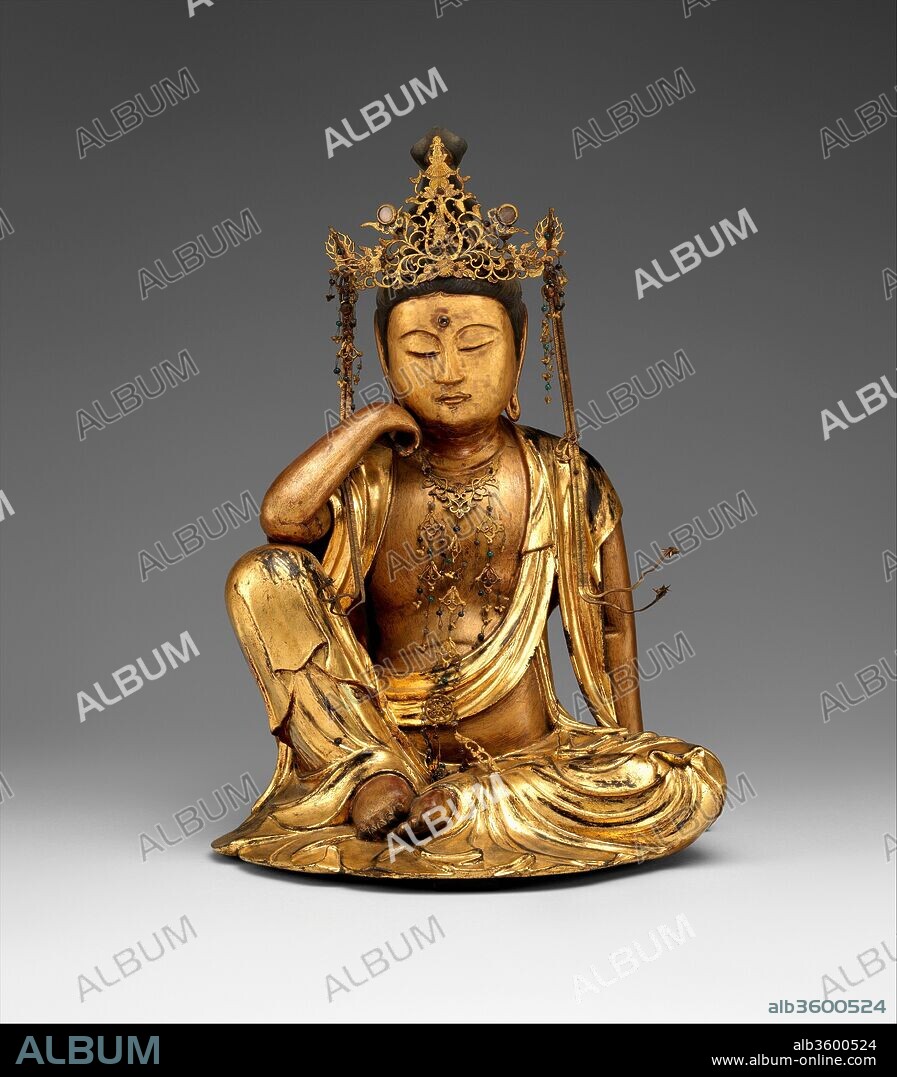alb3600524
Nyoirin Kannon

|
Ajouter à une autre Lightbox |
|
Ajouter à une autre Lightbox |



Avez-vous déjà un compte? S'identifier
Vous n'avez pas de compte ? S'inscrire
Acheter cette image.
Sélectionnez l'usage:

Titre:
Nyoirin Kannon
Légende:
Traduction automatique: Nyoirin Kannon. Culture : Japon. Dimensions : H. 16 9/16 in. (42,1 cm) ; avec 12 1/8 po. (30,8 cm) ; D. 10 1/4 in. (26 cm). Date : du 1693. Le bodhisattva Kannon (Sanskrit : Avalokiteshvara) se manifeste sous de nombreuses formes, dont chacune démontre des aspects de sa compassion et de ses v?ux salvifiques. Cette petite sculpture montre le bodhisattva sous une forme bouddhiste ésotérique appelée Nyoirin, indiquant les attributs les plus couramment tenus dans ses mains, le joyau exauçant les souhaits (nyoi) et la roue (rin) du Dharma, ou enseignements bouddhistes. Alors que de nombreuses images du bodhisattva ont six bras, cette sculpture en a deux. Une inscription gravée dans la base indique qu'il s'agissait d'un ex-voto à un temple donné au cinquième mois de 1693. Comme les noms des donateurs indiquent qu'il s'agissait de femmes, il est possible que la sculpture ait été consacrée à l'occasion d'une fête mensuelle rituel populaire à l'époque d'Edo appelé jukuya-ko, une assemblée de femmes bouddhistes qui a eu lieu le dix-neuvième du mois pour la santé et l'accouchement en toute sécurité des enfants. De nombreuses stèles en relief en pierre représentant une forme à deux bras du bodhisattva dédiée le jour de ce rite datent de la période Edo. Les archives indiquent qu'une assemblée parallèle dédiée à une divinité shintoïste était également répandue à l'époque.
Nyoirin Kannon. Culture: Japan. Dimensions: H. 16 9/16 in. (42.1 cm); W. 12 1/8 in. (30.8 cm); D. 10 1/4 in. (26 cm). Date: dated 1693.
The bodhisattva Kannon (Sanskrit: Avalokiteshvara) manifests in many forms, each of which demonstrates aspects of his compassion and salvific vows. This small sculpture shows the bodhisattva in an Esoteric Buddhist form called Nyoirin, indicating the attributes most commonly held in his hands, the wish-fulfilling jewel (nyoi) and the wheel (rin) of the Dharma, or Buddhist teachings. While many images of the bodhisattva have six arms, this sculpture has two. An inscription carved into the base indicates that it was a votive offering to a temple given in the fifth month of 1693. As the names of the donors indicate that they were women, it is possible that the sculpture was dedicated on the occasion of a monthly ritual popular in the Edo period called the jukuya-ko, an assembly of female Buddhists that took place on the nineteenth of the month for health and the safe delivery of children. Many stone relief stelae depicting a two-armed form of the bodhisattva dedicated on the day of this rite remain from the Edo period. Records indicate that a parallel assembly dedicated to a Shinto deity was also prevalent at the time.
Technique/matériel:
Wood with gold, gold leaf, lacquer, and crystal inlay
Période:
Edo period (1615-1868)
Musée:
Metropolitan Museum of Art, New York, USA
Crédit:
Album
Autorisations:
Taille de l'image:
3549 x 4053 px | 41.2 MB
Taille d'impression:
30.0 x 34.3 cm | 11.8 x 13.5 in (300 dpi)
Mots clés:


 Pinterest
Pinterest Twitter
Twitter Facebook
Facebook Copier le lien
Copier le lien Email
Email
